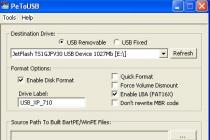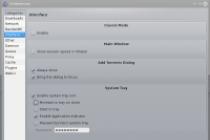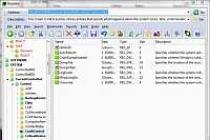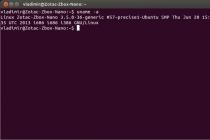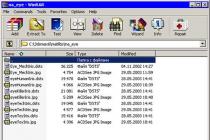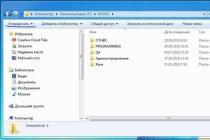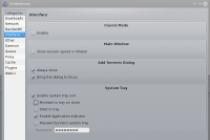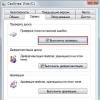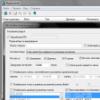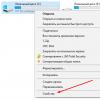Setting up a Wi-Fi router ZyXEL Keenetic Start
The ZyXEL Keenetic Start router allows you to connect up to 4 devices in the apartment using wire lines communication at speeds up to 100 Mbps, and also provides connection wireless devices with speed wireless transmission data up to 150 Mbps. Consider the necessary settings for this router to work in the Insys network.
1. Connecting the router to the PC on which the configuration is being performed:
Connect the incoming cable "Insys" to the blue port on the router ("INTERNET" port), then you need to connect the network card of your PC with one of the four yellow ports on the router ("HOME NETWORK 1-4") with a patch cord. In this case, the settings for obtaining an IP address on the network card should be set to “Obtain automatically”. You can learn more about network settings on the ethernet interface of a PC in the help sections "Instructions for setting up a network in Windows ...":
2. Enter the router setup interface and change the default password:
To enter the router configuration interface, you need to open a browser ( Internet Explorer, Mozilla Firefox, Google Chrome, Opera, etc.) and enter the address http://192.168.1.1/. The default username is admin and the password is admin. If you cannot access the web interface, or the router was previously configured for use in other conditions, we recommend that you restore the factory settings or check the network settings on the PC. The factory settings on this router are restored by pressing the hidden "reset" button for 5-10 seconds. After that, the indicators on the router will turn off and turn on again, which will mean resetting the current settings and restoring the default settings. The settings on the PC should be set to 'Receive Automatically'. You can find out how to change the network settings on the ethernet interface of a PC in the help sections "Instructions for setting up a network in Windows ...". After that, you need to click the "Web configurator" button and change the default password:


3. Setting up access to the Internet:
To configure access to the Internet in the "Internet" section (the planet icon in the bottom panel of the interface), select the "Connections" subsection, click on the "Broadband Connection" connection and enter the following data:

After that, you need to click "Apply".
4. Customization wireless network:
To set up a wireless network in the "Network-Wi-Fi" section (the Wi-Fi icon in the bottom panel of the interface), set the following parameters:

After that, you need to click "Apply".
5. Updating the firmware of the router:
The settings made are enough to access the Internet, but for more stable and high-quality work, it is recommended to update the version of the router's microcontroller. You can do this in the "System - Components" section (gear icon in the bottom panel of the interface). It is necessary to select the necessary components (the most important ones are automatically selected) and click the "Update" button.

6. Router responses to ICMP requests:
To diagnose connection quality when contacting technical support, you must allow your router to respond to ICMP requests. Go to the "Security - Firewall" section (shield icon in the bottom panel of the interface). You must click "Add Rule" and enter the following data:

These settings are enough for comfortable work on the Internet. If you have any questions, you can always contact the 24/7 technical support by phone 8-800-755-05-55.
From the moment it appeared on the market, this router has gained great popularity among the public. The point, of course, is not only in its quality, but also in price. This is the first ZyXEL router in this price range. To buy a quite decent router for a thousand and a few rubles is a great success. And, if this device is from a famous manufacturer, then doubly so. The device differs from more advanced models in the presence of only one antenna and does not have USB ports on the panel. The highest supported data transfer rate is 150 Mbps. Plus there is support for IPTV. We will be interested in the details of setting up the Zyxel Keenetic Start router in relation to the domestic telecom operator Rostelecom.
The beginning of the setup procedure is the same as for any other router: you need to go to the browser on the computer connected to the device, and then type in the address bar - http://192.168.1.1.
Login and password to enter are as follows:
- Login: admin.
- Password: 1234.
A window will appear in which you need to click the button « Quick Setup» - will start "Setup Wizard", with its help, configuring the router can be carried out most simply.
Setup Wizard
The setup wizard guides the user through a series of screens designed to set up a single parameter. Using this wizard to configure the router zyxel keenetic start looks like this: 
- The first window prompts you to specify the MAC address of a specific device. This setting is optional and is only needed if your provider binds the subscriber to the MAC of the network card of his computer. To find out the MAC address of your board, type in the console following instruction: ipconfig /all .
- The second window contains the IP address and DNS of the subscriber. This is also an optional setting, as in the vast majority of cases, an IP address is assigned automatically. If this is not the case, write here the IP address and the address of the DNS server.
- The third window is the authorization window for connecting to your ISP. Here you specify your login and password in the network of a particular provider. To do this, you will need to uncheck "I don't have a password to access" and enter the required values. In many cases, they are not required.
- The fourth window contains a summary of the settings you have made. The master has completed his work and offers to go to the so-called. "Web configurator"- NDMS V2 interface.
The second part of the "Marleson ballet"
After launching the web configurator, you will need to change default password to access settings for something else. The next steps look like this:

If everything is done correctly, then the network should immediately start working. The above instructions are suitable for the zyxel keenetic start router with the Rostelecom provider, for other providers the procedure may differ. As an example, let's take the settings of the router under Beeline.
Instructions for "Beeline"
The web configuration for Beeline, although produced in the same window "Authorization", differs from the configuration for Rostelecom in several points. First, instead of the PPoE connection type, we set the L2TP type. Secondly, - we set the name of the future network in the field called "Description". Thirdly, the server address in this case is not empty, but contains the value tp.internet.beeline.ru . And finally, you need to set authentication data - for Beeline, the login field is filled in with the personal account number with this provider. Otherwise, all settings repeat the configuration of Rostelecom. After specifying the parameters, do not forget to click the button "Apply".
Buying expensive equipment is not always advisable. If you are choosing a router for home or office, it is better to pay attention to budget copies, for example, Keenetic Start model from Zyxel. It was designed as a reliable device for sharing LAN and Wi-Fi network for multiple users. Consider the router, its main characteristics and capabilities in more detail.
The Start Keenetic router works from a regular 220 V network, it is completely autonomous, easy to configure and does not require maintenance.
The model has all the necessary functionality to connect to the Internet. But its main difference from more expensive models is reliability.
Keenetic is designed to provide a seamless experience for all electronic devices at home with global network". The functionality allows you to configure several types of connection - Link DUO - to the provider:
- Directly to the Internet.
- Through the local resources of providers, the so-called district network.
Network types
 Also, the Start Keenetic router creates two types of networks: home and guest. The following devices are connected to the home:
Also, the Start Keenetic router creates two types of networks: home and guest. The following devices are connected to the home:
- Receiver for IPTV.
- Computers in the amount of four units via LAN (wired).
- Smartphones, laptops and IP cameras via wireless connection. The quantity is set by the user.
The guest network is configured to wirelessly connect to the Start Keenetic router, bypassing home network thus guaranteeing the safety of personal data.
The first model of the Start Keenetic router, unfortunately, does not have the ability to connect several providers and add a backup 3/4G channel. There is also no possibility of connecting an external drive and, as a result, installing a torrent client. There is no DLNA server to manage media files from the phone.
Connection types
 The main purpose of Start Keenetic is to provide access to the Internet via a line allocated by the provider. The model works with various types connections:
The main purpose of Start Keenetic is to provide access to the Internet via a line allocated by the provider. The model works with various types connections:
- VPN (PPTP and L2TP).
- VLAN 802.1Q.
- PPPoE.
- IPv4/IPv6.
- 802.1X.
The MIPS processor provides the ability to work with file hosting services from several devices at once at speeds up to 80 Mb / s in total.
Wireless wifi connection works according to the latest 802.11n protocol at the moment, providing data transfer at speeds up to 150 Mb / s. For the convenience of authorization, interaction with WPS standard devices is built-in.
Thus, connecting a new device takes a few seconds.
Additional functionality
 V general package Keenetic features built in free service"Yandex.DNS", protecting a PC or smartphone from malicious sites and resources for adults. The built-in Internet filter also blocks the download of infected files and warns you about untrusted pages.
V general package Keenetic features built in free service"Yandex.DNS", protecting a PC or smartphone from malicious sites and resources for adults. The built-in Internet filter also blocks the download of infected files and warns you about untrusted pages.
 To work with devices local network The router has a built-in managed switch. It connects computers, receivers and other devices at speeds of 10/100 Mbps. To simplify the user experience, Start Keenetic is also equipped with a DHCP server that automatically issues an IP address to each new device.
To work with devices local network The router has a built-in managed switch. It connects computers, receivers and other devices at speeds of 10/100 Mbps. To simplify the user experience, Start Keenetic is also equipped with a DHCP server that automatically issues an IP address to each new device.
 If there are children in the house, the function will come in handy. parental control provided by the SkyDNS service. With the help of this service, the categories of sites available to the child are independently selected, and filters are created to limit it.
If there are children in the house, the function will come in handy. parental control provided by the SkyDNS service. With the help of this service, the categories of sites available to the child are independently selected, and filters are created to limit it.
 With Start Keenetic and DynDNS and NO-IP clients, it is possible to get remote access to your router. And also create file and web servers, share them with friends. In addition, use the server to monitor the house online by installing a network camera.
With Start Keenetic and DynDNS and NO-IP clients, it is possible to get remote access to your router. And also create file and web servers, share them with friends. In addition, use the server to monitor the house online by installing a network camera.
In general, these are all the characteristics, the description of which will help you understand the Keenetic model.
Appearance
 Start looks like a rectangular box made of glossy plastic with a ribbed pattern around the body. The front is equipped with indicators showing:
Start looks like a rectangular box made of glossy plastic with a ribbed pattern around the body. The front is equipped with indicators showing:
- Internet connection.
- Number of devices connected via LAN.
- Availability of food.
- Wi-Fi status (on/off).
- Successfully or not, the Start Keenetic router was authorized by the provider.
 In the right upper corner there is a button WiFi control. There are five RJ-45 Lan-cable connectors on the back. Four are for connecting network devices, the fifth is for. And also on the back there is a connector for connecting the power supply, a Reset button to reset the settings and a power button. The standard kit comes with one antenna for amplifying the wireless signal.
In the right upper corner there is a button WiFi control. There are five RJ-45 Lan-cable connectors on the back. Four are for connecting network devices, the fifth is for. And also on the back there is a connector for connecting the power supply, a Reset button to reset the settings and a power button. The standard kit comes with one antenna for amplifying the wireless signal.
Connection and preparation for work
Before starting the Start Keenetic router for the first time, it is necessary to assemble it. If you plan to connect a PC via a LAN cable, you will need a wire crimped on both sides with connectors. One end is connected to the network card on a computer or laptop, the other end is connected directly to the Start Keenetic router. After that, you need to connect a cable with the Internet from the provider to the port for the external WAN connection.
At the last stage, the power supply is connected. First, a wire from the unit is connected to the connector designated as “5V 2A”, and only after that the unit itself is built into the 220V network. 
 For the Zyxel Keenetic start router, the setup takes place when access to the Internet is provided. It is performed through a browser, and at the first start, this procedure is performed via wired and wireless connections. If the network is encrypted, the default password used is indicated on the router itself or in its documentation. Configurations are configured manually or through the "Setup Wizard".
For the Zyxel Keenetic start router, the setup takes place when access to the Internet is provided. It is performed through a browser, and at the first start, this procedure is performed via wired and wireless connections. If the network is encrypted, the default password used is indicated on the router itself or in its documentation. Configurations are configured manually or through the "Setup Wizard".
Settings
As already mentioned, to set up Kinetic Start, you need to go through the browser on any device connected to the router. You don't need to have internet access for this. Having opened any browser, in the line for entering the address you will need to drive in the IP of the modem.  It is indicated on the box with the device. But if there is no such data, the standard address for Zyxel Keenetic Start 2 and the first model is 192.168.1.1. If the connection fails, you need to change the line to 192.168.0.1.
It is indicated on the box with the device. But if there is no such data, the standard address for Zyxel Keenetic Start 2 and the first model is 192.168.1.1. If the connection fails, you need to change the line to 192.168.0.1.
 When connecting several devices to a computer, a completely different address is assigned to the Start Keenetic router. To find out the exact IP on Windows 7 and older, go to the "Manage networks and public access”, and then the menu “Change adapter settings”. All devices - local and virtual - connected to the network card are displayed here. All of them are signed, so the modem can be found immediately.
When connecting several devices to a computer, a completely different address is assigned to the Start Keenetic router. To find out the exact IP on Windows 7 and older, go to the "Manage networks and public access”, and then the menu “Change adapter settings”. All devices - local and virtual - connected to the network card are displayed here. All of them are signed, so the modem can be found immediately.
 Then you need to double-click on the Start Keenetic connection icon and then click on the "Details" button. Find the line "Default IP Gateway". Enter the details of this particular line in the browser.
Then you need to double-click on the Start Keenetic connection icon and then click on the "Details" button. Find the line "Default IP Gateway". Enter the details of this particular line in the browser.
If everything is done correctly, a window will open where it is proposed to quickly configure the system in two modes: manual and automatic. Let's take a closer look at each of them.
Automatic setting
 To start the installation of Start Keenetic automatically, click the "Quick Setup" button. A window will appear where the connection will be checked offline, a menu will open with fields for authorization. Here you need to enter the login and password received from the service provider company. If the provider uses a PPPoE connection, you need to tick the box in the "Provider provided ..." box and select the server. After all authorization data is entered, click the "Next" button.
To start the installation of Start Keenetic automatically, click the "Quick Setup" button. A window will appear where the connection will be checked offline, a menu will open with fields for authorization. Here you need to enter the login and password received from the service provider company. If the provider uses a PPPoE connection, you need to tick the box in the "Provider provided ..." box and select the server. After all authorization data is entered, click the "Next" button.
 The Start Keenetic modem will automatically check for updates on its server. If there are any, you must click "Update". Then the components will be installed. During installation, you can not turn off the PC and the router itself, you must wait until the procedure is completed. After the update is completed, the device will reboot automatically, all configurations will be saved.
The Start Keenetic modem will automatically check for updates on its server. If there are any, you must click "Update". Then the components will be installed. During installation, you can not turn off the PC and the router itself, you must wait until the procedure is completed. After the update is completed, the device will reboot automatically, all configurations will be saved.
After the update, a window will appear with a message containing a proposal to connect the secure Internet function provided by Yandex.DNS. The service is useful, but not required. If the Internet is weak, it is better to turn it off by unchecking the corresponding box. Now click the "Next" button and enjoy browsing the Internet.
Connecting to the Internet manually using some providers as an example
Connecting Start Keenetic manually depends on the type of connection used by the ISP.
Dom.ru and Rostelecom
 First, let's figure out how to establish a connection with a provider using the PPPoE protocol used by most providers. The first step is to go to the Start settings if this is the first launch of the router. Then, when choosing the type of setup, choose not quick, but "Web configurator". If this is not the first launch, you need to go to the "Internet" section located in the bottom panel and then go to the PPPoE / VPN tab. Then click on the "Add new connection" button.
First, let's figure out how to establish a connection with a provider using the PPPoE protocol used by most providers. The first step is to go to the Start settings if this is the first launch of the router. Then, when choosing the type of setup, choose not quick, but "Web configurator". If this is not the first launch, you need to go to the "Internet" section located in the bottom panel and then go to the PPPoE / VPN tab. Then click on the "Add new connection" button.
 The "Connection settings" submenu will open, in the first two fields you need to check the boxes. The tags will be responsible for the fact that Keenetic uses this particular protocol to access the Internet. In the "Description" line, you must enter the future name of the connection, while using any name. Protocol type: PPPoE. Next in the drop-down list "Connect via ..." you must select Broadband connection.
The "Connection settings" submenu will open, in the first two fields you need to check the boxes. The tags will be responsible for the fact that Keenetic uses this particular protocol to access the Internet. In the "Description" line, you must enter the future name of the connection, while using any name. Protocol type: PPPoE. Next in the drop-down list "Connect via ..." you must select Broadband connection.
The following: "Username" and "Password" are provided by the provider in the contract. The specified data must be entered in these two fields. The rest should be left as default. The last step is to click the "Apply" button. To check if the connection is working, go to the Start “Connections” section of the router. A label with a green check mark should appear next to the new line with the description that was invented.
"Beeline"
 To create a connection to the Beeline provider, you will need to go back to the Keenetic settings, the Internet section and select the L2TP connection. This type manual setting suitable for both Zyxel Keenetic Start ii and the first version. In the first paragraph, check the box next to "Enable interface". Next, come up with a name for the future connection. The name will appear in the connection bar. The line "Connect via ..." requires the choice of Broadband connection.
To create a connection to the Beeline provider, you will need to go back to the Keenetic settings, the Internet section and select the L2TP connection. This type manual setting suitable for both Zyxel Keenetic Start ii and the first version. In the first paragraph, check the box next to "Enable interface". Next, come up with a name for the future connection. The name will appear in the connection bar. The line "Connect via ..." requires the choice of Broadband connection.
For the main section: "Use to access ..." is checked. In the line "Server address" enter tp.internet.beeline.ru. The login and password fields are filled in with data provided by the Beeline operator. The very last TCP-MSS section is also checked.
That's it, now Start Keenetic is connected to an Internet service provider.
NetByNet
The NetByNet operator uses several connection types, including PPPoE or l2tp. But most often it is DHCP and binding by MAC address, as well as through a static IP address. The Keenetic modem is connected in any way. The first two types of connection were described for the Beeline and Rostelecom operators, so we will analyze the latest methods in detail.
To connect via IP, in the "Internet" section, select IPoE from the list of available protocols. 
First of all, you need to select the connector through which the Start Keenetic connection to the Internet will be provided. Therefore, two checkboxes are required under the rightmost WAN connector. Opposite the "Enable interface" line, check the box, and in the "Description" section add any connection name, relying on your own choice.
The next VLAN ID field remains the default. The number 8 must be entered here. To obtain an IP address and subnet mask, you can contact your provider, but the data must be specified in the contract. Next, opposite DHCP, uncheck the box and put it in the very last section: "This is a direct connection ...". 
It remains only to configure DNS servers for router Start. To do this, go to the appropriate section, located in the same place as IPoE. Servers are issued by the provider, but if they are not available, third-party resources are used. For example, the value 212.1.224.6 is entered in both lines, the configuration is saved. 
To organize a Keenetic connection via a MAC address, you need to contact NetByNet technical support. The MAC is located on the bottom of the router. Employees themselves will bind the Keenetic router. After that, the user will need to make a connection like the previous IPoE. At the same time, leave the IP address and subnet mask fields empty, and check the boxes in all other sections. 
 To set up Wi-Fi, you need to go to the Keenetic configurations. Then, in the lower menu, find the icon of the corresponding wireless network. The Access Point submenu will open. To turn it on or off, check / uncheck the box next to the "Enable access point" line.
To set up Wi-Fi, you need to go to the Keenetic configurations. Then, in the lower menu, find the icon of the corresponding wireless network. The Access Point submenu will open. To turn it on or off, check / uncheck the box next to the "Enable access point" line.
Now directly about the Wi-Fi settings on Keenetic. The second field is the SSID network name, the factory name Keenetic-**** is used by default. It is easy to change it to any other, if necessary. Also at the bottom there is a setting that allows you to hide your personal network from strangers - the "Hide SSID" submenu. In this case, only authorized devices will be able to connect to Wi-Fi.
If you want to connect a laptop or smartphone to hidden Wi-Fi, you will have to enter your username and password in the “Wireless Network Connections” menu on the Start device. In this case, the gadget will start searching for a network, find it and log in. But only with the correct login, otherwise the connection will not occur.
 The next field after the SSID is Network Security. Here you need to select the security protocol. The WPA2 protocol is the most reliable at the moment, but a new one will soon be introduced - WPA3, which provides a number of additional protections for Wi-Fi enabled devices.
The next field after the SSID is Network Security. Here you need to select the security protocol. The WPA2 protocol is the most reliable at the moment, but a new one will soon be introduced - WPA3, which provides a number of additional protections for Wi-Fi enabled devices.
If you are not using a password and the network is public, an empty encryption field is selected. After selecting the protocol, you will need to enter a password in the bottom line, one of 8 characters is enough. The code consists of any characters of the selected case (uppercase, uppercase) and special characters with numbers.
These were the basic security settings on Keenetic. Now you need to specify the region. The default is Russian Federation, which is the correct setting. After the standard of the latest version comes, 802.11bgn is automatically installed. Thanks to him, the router offline selects the maximum data transfer rate for the connected device, from 10 to 150 Mbps.
 The choice of channel affects the data transfer rate, as well as the correct operation. The more devices on the same channel, the greater the delay in sending data. The number of "broken" packets when sent will increase, which reduces the transmission speed. The main problem is that the channels are used by all routers that are in the same range. Therefore, it is quite difficult to find an empty one. As a rule, channels from 3-8 are least used. To determine the purity of the channel, applications on the smartphone are used.
The choice of channel affects the data transfer rate, as well as the correct operation. The more devices on the same channel, the greater the delay in sending data. The number of "broken" packets when sent will increase, which reduces the transmission speed. The main problem is that the channels are used by all routers that are in the same range. Therefore, it is quite difficult to find an empty one. As a rule, channels from 3-8 are least used. To determine the purity of the channel, applications on the smartphone are used.
 The next field - "Signal Strength" - is responsible for the area over which the wireless network will be distributed. The parameter is self-adjusting for specific user needs. You need to know that concrete walls and the presence of wiring greatly reduce the range. To improve the signal, the antenna should be in a vertical position, and the router itself should be at a height of 1-1.5 meters from the floor level.
The next field - "Signal Strength" - is responsible for the area over which the wireless network will be distributed. The parameter is self-adjusting for specific user needs. You need to know that concrete walls and the presence of wiring greatly reduce the range. To improve the signal, the antenna should be in a vertical position, and the router itself should be at a height of 1-1.5 meters from the floor level.
WPS
 The last section is the WPS function. It is used for simplified connection to Keenetic devices that have a similar capability. WPS is activated both in setup mode and when you press the Wi-Fi power button on the router itself. The main thing to remember is that on the Start model, a quick press of the button is responsible for turning WPS on / off. But if you press the key for a few seconds, the network settings will be reset, and everything will have to be done again. To connect any device wirelessly using WPS with a Keenetic router, you must enable this feature on both gadgets. After that, during verification, a button for normal connection and connection using WPS will appear on the smartphone or laptop. Pressing the latter will authorize the network without entering a password.
The last section is the WPS function. It is used for simplified connection to Keenetic devices that have a similar capability. WPS is activated both in setup mode and when you press the Wi-Fi power button on the router itself. The main thing to remember is that on the Start model, a quick press of the button is responsible for turning WPS on / off. But if you press the key for a few seconds, the network settings will be reset, and everything will have to be done again. To connect any device wirelessly using WPS with a Keenetic router, you must enable this feature on both gadgets. After that, during verification, a button for normal connection and connection using WPS will appear on the smartphone or laptop. Pressing the latter will authorize the network without entering a password.
Setting up as a repeater (repeater), amplifier, adapter or access point
 The Start router can be configured in any of the above modes. To do this, in the configurations, go to the settings tab and the "Modes" section:
The Start router can be configured in any of the above modes. To do this, in the configurations, go to the settings tab and the "Modes" section:
After selecting the mode, you will need to restart the modem. If Keenetic will be used as an amplifier, Internet access is not needed on it. The main thing is that the first router whose signal needs to be amplified has such access, and both of them work in WiFi mode. The Start router will automatically “catch” the signal and amplify it.
IPTV
 To connect the set-top box, the latest firmware version must be installed on the Keenetic router. How this is done will be discussed later in the article. After updating the firmware, connect the receiver to one of the four LAN ports. But not to the WAN port used to access the Internet. Then go to the Start modem configurations, the WAN section and in the "Select ports" line indicate the connector to which the receiver is connected. It is also necessary to drive in the IP and password data issued by the provider.
To connect the set-top box, the latest firmware version must be installed on the Keenetic router. How this is done will be discussed later in the article. After updating the firmware, connect the receiver to one of the four LAN ports. But not to the WAN port used to access the Internet. Then go to the Start modem configurations, the WAN section and in the "Select ports" line indicate the connector to which the receiver is connected. It is also necessary to drive in the IP and password data issued by the provider.
IPv6 protocol
 To set up a connection over an IPv6 tunnel, you need to go to the Start setting and select the required connection protocol in the Internet tab. Then click the "Add connection" button. A window with settings will open, in the first two lines you need to check the boxes. The "Description" section must be filled in, here you need to enter the invented name of the future network.
To set up a connection over an IPv6 tunnel, you need to go to the Start setting and select the required connection protocol in the Internet tab. Then click the "Add connection" button. A window with settings will open, in the first two lines you need to check the boxes. The "Description" section must be filled in, here you need to enter the invented name of the future network.
The IPv6 protocol in the Keenetic router works by creating a tunnel between IPv4 and new version. Therefore, to create it, you will need data provided by the provider. If there are any, they fill in the "Server Address" and "IPv6 Address" columns. In the line "IPv6 Prefix" you need to enter the previous line without the "mask", that is, without the characters "/64" and click "Apply". Everything, now Start works on a new protocol.
Dynamic DNS
 The connection of this function in the Keenetic model is carried out through external services. If you already have a ready-made subdomain registered on one of the third-party resources, you need to go to the DyDNS tab. In the "Used service" section, select "Other". The URL that was issued earlier and copied on a third-party site is inserted into the "Server Address". After that, the correct domain name is entered. The "Name" and "Password" fields must be left blank. In the last line “Using DDNS”, check the box and click “Update”.
The connection of this function in the Keenetic model is carried out through external services. If you already have a ready-made subdomain registered on one of the third-party resources, you need to go to the DyDNS tab. In the "Used service" section, select "Other". The URL that was issued earlier and copied on a third-party site is inserted into the "Server Address". After that, the correct domain name is entered. The "Name" and "Password" fields must be left blank. In the last line “Using DDNS”, check the box and click “Update”.
Security settings (antivirus, firewall)
To go to the security settings on the Start router, you need to go to the "Security -> Firewall" section. Here, rules are set that restrict access to certain sites. 
Going to the configurations, you must click the "Add rule" button, after which the necessary window will open. Here you can choose whether the rule will prohibit something or, conversely, allow it. Also, Ziksel Kinetic Start chooses in which order the filter will be applied: for the home network or external addresses. To set filtering for visited resources, you need to create rules for the TCP, UDP and ICMP protocols and leave the "Ports" line in the "Any" position. 
Parental control
For installation on Keenetic modems, a schedule function is provided. It is located in "Settings", section "System -> Schedule". 
Clicking on the button adds a new schedule. The menu has a convenient system for regulating the broadcast. It is possible to limit several networks:
- Internet entirely.
- WiFi.
- Guest WiFi.
The menu has a choice of which specific device With limited access. After all configurations are set, click the "Apply" button, the filter will start working. 
Printer setup
Unfortunately, due to the lack of a USB connector on the Start model, there is no direct connection of the printer to the Keenetic.
Setting up a VPN server
 To connect a VPN server on Keenetic, go to the network settings and select the PPPoE/VPN protocol. Fill in the column "Description", for example, enter VPN. Protocol type - L2TP. In the "Connect via ..." submenu, you must leave the setting defined by the Start Keenetic router. In the next two fields - "Login" / "Password" - enter the data provided by the provider. Column "Server Address" designate the server provided by the Internet provider. Save configuration.
To connect a VPN server on Keenetic, go to the network settings and select the PPPoE/VPN protocol. Fill in the column "Description", for example, enter VPN. Protocol type - L2TP. In the "Connect via ..." submenu, you must leave the setting defined by the Start Keenetic router. In the next two fields - "Login" / "Password" - enter the data provided by the provider. Column "Server Address" designate the server provided by the Internet provider. Save configuration.
Possible malfunctions and ways to eliminate them
Most of the problems that appear when working with the Internet are solved by resetting the settings to the factory settings. If there is no connection or it works slowly, it is worth checking if someone else has connected.
You also need to carefully monitor that the Start router does not overheat and is regularly cleaned of dust.
Start Keenetic firmware update
The software needs to be updated for correct operation home device. Later versions of the firmware are not only stable, but also have advanced functionality. Installation on Start Keenetic is done in several ways. Let's analyze each of the options.
Via web interface
 To update the firmware on Keenetic from a computer, you need to download from the official website latest version Router software. In the Start settings, go to the "System -> Configuration" sections. The page shows a list of files. Click on the one that is highlighted in blue and with a gear on the label. You will be prompted to select a new file. This is where the previously downloaded firmware for the Keenetic model comes in handy. During the installation of updated software, in no case should you turn off the device or restart it. You need to wait until everything goes automatically.
To update the firmware on Keenetic from a computer, you need to download from the official website latest version Router software. In the Start settings, go to the "System -> Configuration" sections. The page shows a list of files. Click on the one that is highlighted in blue and with a gear on the label. You will be prompted to select a new file. This is where the previously downloaded firmware for the Keenetic model comes in handy. During the installation of updated software, in no case should you turn off the device or restart it. You need to wait until everything goes automatically.
Via mobile app
To update the firmware of the device through a phone or tablet, you need to do the same operations as when installing from a computer.
Resetting the Start Keenetic router to factory settings
 To reset the settings on the Ziksel Start modem, there is a special key located on the back of the device, near the Wi-Fi antenna. To reset, hold it down for 10 seconds. To do this, it is best to use a needle or an awl with a thin forearm.
To reset the settings on the Ziksel Start modem, there is a special key located on the back of the device, near the Wi-Fi antenna. To reset, hold it down for 10 seconds. To do this, it is best to use a needle or an awl with a thin forearm.
Conclusion
Router Start Keenetic – good decision if you need a reliable and inexpensive modem for your home or small office. The router is equipped with a convenient web configurator and many useful features.
Pros of Start Keenetic
Among the advantages of the router are the following:
- Choice of protocols.
- The presence of a network filter.
- Built-in DNS.Yandex system for filtering sites and downloaded files.
- SkyDNS to restrict access to non-child content.
Minuses
Among the shortcomings are highlighted:
- The lack of a USB port, which distinguishes these routers from fellow Start Keenetic 4G and Light.
- The lack of USB sharply limits the functionality: there is no torrent client, the ability to connect a printer.
The Zyxel Keenetic family of home wireless routers is significantly different from many similar products on the market. These solutions are developed and officially supplied only in the markets of Russia and the CIS. The most interesting for our users in them is software, created taking into account the peculiarities of domestic providers and their services. In addition, a significant role in its development is played by the location of developers close to the direct users of the products.
Last fall, the company introduced two new devices that are positioned in upper segment– Keenetic Giga III and Keenetic Ultra II models. And recently a new representative appeared on the market entry level- the Keenetic Start II model, about which the story will go. Its cost at the time of publication is about 1500 rubles.
Appearance
The router comes in a compact (compared to previous Zyxel solutions) cardboard box, for which blue tones were chosen. The delivery set is minimally sufficient - a router, a power supply unit (9 V 0.6 A) and instructions. Note that the product was originally developed with the Russian language everywhere - from the box to the Web interface, not to mention the website and technical support, and we can rather talk about adding an English version than localization for our market.
The network patch cord was probably not added on purpose, since this is the age of mobile clients. In addition, the router can be perfectly configured “over the air”, including from mobile devices.

In appearance, the router is similar to other devices in the series. Black plastic is used, and we see a practical matte version only on the ends, while the top and bottom panels are glossy.

The body dimensions are about 14x10.5x3 centimeters, excluding antennas. The latter are fixed, have two degrees of freedom and are installed on the side ends. The total length is 18 cm, and the moving part is 16.5 cm. Inside, 5 dBi antennas are installed almost the entire length in the form printed circuit boards, which is more interesting than those used in previous models budget segment options.

There are ventilation grilles on the side ends of the case, but it is unlikely that they are necessary in this case. There is one button on the top of the case, for which you can assign actions for one press, double press and long press. By default, it performs the function of connecting clients via WPS and turning Wi-Fi on / off. Three dim green indicators are installed on the front end - status, Wi-Fi and Internet.

On the back, there are two 10/100 Mbps network ports with built-in activity indicators, a hidden reset button, and a power input. Reducing the number of wired ports is another conscious cost reduction move based on the company's own statistics. This, in particular, leads to the impossibility of simultaneously connecting computers and a TV set-top box, which needs its own dedicated port, via cable.

We note the presence at the bottom of two rubber legs and two plastic protrusions, which also act as a wall mount. Between them there is a sticker with a unique name and password for the wireless network, MAC address and other data.

Configuration
The router is assembled on the basis of a MediaTek MT7628N single-chip system with one 575 MHz computing core. Volume random access memory DDR2 is 64 MB and flash memory is 8 MB. There are only two wired ports, as we wrote above. Their maximum speed is 100 Mbps. For wireless clients, there is an access point that supports 802.11b/g/n in the 2.4GHz band with a maximum connection speed of 300Mbps. Note that there is no hardware NAT in this platform, but there are dedicated blocks for the implementation of some other resource-intensive algorithms.
In general, this is quite a typical modern budget option. Of the features, we note the presence of only two wired ports, as well as the installation of two antennas.
Software
The firmware of Zyxel Keenetic routers has a modular structure and supports updating via the Internet. Before testing, firmware version V2.07(ABCM.2) was installed on the device. Appearance interface and software capabilities are unified with other devices. The difference can only be due to differences in the hardware configuration (for example, the presence of a second wireless interface or USB ports).

So, in addition to convenient operation control, flexible options for connecting to providers, setting up IPTV services, a guest wireless network, port translation rules, firewall, there are also such interesting and useful features, as cloud access for monitoring and management, udpxy server (UDP-HTTP proxy), KeenDNS (proprietary dynamic DNS service), modules for working with SkyDNS and Yandex.DNS, client bandwidth control, PPTP VPN remote access server and even a module work with IPsec. Note that cloud KeenDNS is able to provide remote control router even if it uses a "gray" address from the provider.

Performance
This device belongs to the budget segment and is unlikely to be used with high-speed (more than 100 Mbps) Internet connections, gigabit clients or network drives. So you need to evaluate it taking into account work with "ordinary" computers and laptops, as well as inexpensive smartphones and tablets.
Despite the fact that there is only one wired port here and, most likely, many simply will not be used, the assessment of the speed of routing over cable in various modes help you understand the capabilities of the platform.

Considering the platform used and the software optimizations implemented by the company's programmers, we expected exactly such results. We can safely say that the device copes with all connection options at speeds up to 100 Mbps, including in duplex mode. So even in the budget segment today you can find routers that do not limit the performance of mass options for Internet connections.
Recall that this device has only one port for connecting clients via cable. Today, in our opinion, this is quite acceptable for many users who only need a wireless connection for smartphones, laptops and tablets. However, another trouble lurks here - the 2.4 GHz band in urban areas is very densely occupied, so a situation may well arise that a single-band router will not be able to provide the required speeds and coverage. At the same time, the user has no way to solve this problem, except to switch to the 5 GHz band or install an access point in each room, which leads to a significant increase in the cost of the solution (not to mention the fact that 5 GHz is also rare for low-cost clients ). This is perhaps the most significant point that you should pay attention to in the budget segment. Note that improving the antennas or increasing the power of your router, as well as replacing it with a different (single-band) router, unfortunately, may not provide any significant advantage in this situation.
Keenetic Start II uses a dual antenna configuration, which gives a maximum connection speed of 300 Mbps. However, many cheap smartphones and tablets will only be able to connect at 65 or 72 Mbps due to the presence of only one built-in antenna and the lack of “wide channel” support, and of course the router is not to blame. Add to this the fact that the real speed is usually half the connection speed and 100 Mbps ports of the router, and the results presented in the following graph will not surprise us.

WITH good adapter Asus PCE-AC68, which will obviously not be used with this router in practice, you can get 80-90 Mbps, and with an inexpensive carrier smartphone - about 30-50 Mbps. The test was conducted at a distance of about four meters line of sight in one room.
The last performance test we ran with this device was the speed of the built-in PPTP server. It allows (in the presence of a "white" address from the provider) to implement secure remote access to your local network from almost any type of client equipment. The graph shows the results averaged over the scenarios of receiving, transmitting and full duplex data exchange.

When using MPPE, the router provides about 30 Mbps, but if it suits the option without encryption, then the speed will be 70 Mbps or more, depending on the type of Internet connection.
Conclusion
The Zyxel Keenetic Start II router is a budget segment model that is interesting for its software and a fairly fast hardware platform. The device has a traditional case design with the ability to mount on the wall. Please note that the router is positioned not only as an addition to the current line, but also as a universal inexpensive device, capable of acting as a router for wireless clients, and being an access point or repeater. Thus, the installation of only two network ports is just a feature of this model. Having a 2.4GHz-only access point is to be expected in this segment, and its performance is highly dependent on the radio environment at the place of use. At the same time, the router is equipped with a fast processor that can handle routing at speeds up to 100 Mbps, inclusive, with any type of connection. The embedded software supports the latest technologies and standards in our market, and also has many additional features, of which, first of all, cloud access, udpxy service, SkyDNS and Yandex.DNS support, bandwidth management, VPN servers and alternate modes work.
By the way, it is worth noting that Keenetic Lite III (about 1900 rubles) and Keenetic 4G III (about 2300 rubles) have recently switched to a similar hardware platform, which now have revision B. So the performance test results presented in this material will be true for them as well. .

